Lake Sunfish, or simply Sunfish, is a freshwater fish native to North America. This fish is popular as game fish among anglers because of its fighting ability. Although they are edible, Lake Sunfish is not sold as a commercial food.
Let’s find out where they live, how they look, their behavior, and more facts about Lake Sunfish in this article.
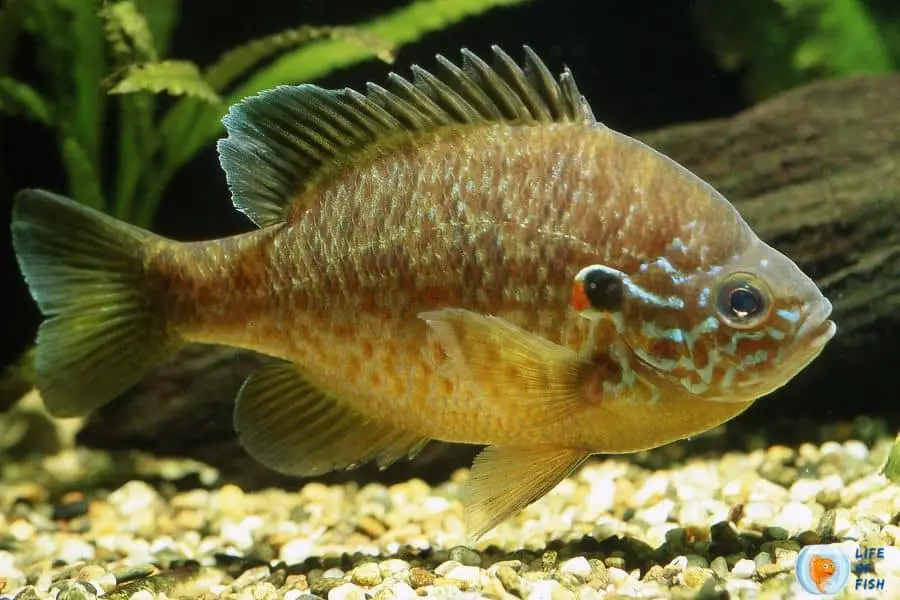
What is Lake Sunfish?
Jump To
Sunfish scientifically belong to the Centrarchidae family. It is a family of freshwater fish belonging to the order Perciformes.
They are ray-finned fish that comprises 38 species, 2 of which are extinct. Also sunfish native to North America, there are eight genera of Centrarchidae.
Famous sunfish groups are;
- Lepomis (Sunfishes)
- Pomoxis (Crappie)
- Enneacanthus (Banded sunfishes)
- Micropterus (Black basses)
- Centrarchus (Flier)
- Archoplites (Sacramento perch)
- Ambloplites (Rock basses) and
- Acantharchus (Mud sunfish).
Many sunfish species are familiar among North Americans as game fish, including the rock bass, largemouth bass, pumpkinseed, Green Sunfish, Bluegill, and crappies.
Lake sunfish live in lakes, ponds, streams, rivers, and swamps in North America.
However, some of these species are distributed around multiple continents, including Europe, South America, Africa, and Asia, due to external introductions.
The native species of some countries have become altered and reduced because of Centrarchidae, especially in Italy, South Africa, Japan, and Madagascar.
Therefore, Lake Sunfish are also famous as invasive fish species.
How Lake Sunfish looks like
Members of the Sunfish family generally have a deep, laterally compressed body shape, three to eight anal fins, and two dorsal fins. They range from just 3.1 inches to 2.2 feet in extreme cases.
Color
Since this is a family of 36 extant (currently living) species, they come in different colors. Below is a list of some colors of some common Sunfish.
- Black Crappie (Pomoxis negromaculatus)- dark, black mottling on a silvery-gray to white body-color
- Bluegill Sunfish (Lepomis macrochirus) – Face and gills are deep blue and purple, dark olive-colored sidebands and a blazing orange to yellow belly
- Bluespotted Sunfish (Enneacanthus gloriosus) – Males have dark sides, and females have light sides with blue to silver spots along the body. Vertical fins have scattering dark blue patches on a pale gray background.
- Green Sunfish (Lepomis cyanellus) – The back and sides are bluish-green, and the belly is pale yellow or white.
- Largemouth Bass (Micropterus salmoides) – The fish’s back is olive green, with an off-white abdomen covered in small ctenoid scales. They can change the color a bit like a chameleon.
- Mud Sunfish (Acantharchus pomotis) – The top is reddish-brown, and the belly is pale brown.
- Pumpkinseed Sunfish (Lepomis gibbosus) – On the back, this fish is dark olive-green with mottled sides. On the rear of its ear flap, there is a crimson mask in the shape of a half-moon. Its sides are yellowish in color and spotted with orange, red, and blue. Its belly ranges from yellow to brilliant orange.
- Rock Bass (Ambloplites rupestris) – sides are greenish or brownish with horizontal rows of black dots. They have substantial red to orange-red eyes.
Shape
Most Sunfish have a deep, laterally compressed body. This shape gives this fish a thin and round “pancake-like” appearance.
They have two dorsal rays in which the first have stiff spines and the second has soft rays. Both dorsal fins are fused together, and they provide protection from predators.
The front section of the anal fins has three to six spines. The tail (caudal fin) is notched or slightly forked.
Located at the front of the fish, paired pectoral fins and pelvic fins help the fish make short movements with frequent turns rather than glide quickly through the water.
Size
The body size of Lake Sunfish ranges from just 8 cm (3.1 in) in length to almost 1 m (3.3 ft.) in extreme cases.
The largest fish in this family is the largemouth bass. The smallest lake sunfish is the black-banded Sunfish.
Sunfish are widely spread across North America and are one of the favorite sporting fish in those areas.
Life span
The average lifespan of a sunfish is 4 to 6 years. However, some sunfish species, like Bluegill sunfish, live for around ten years.
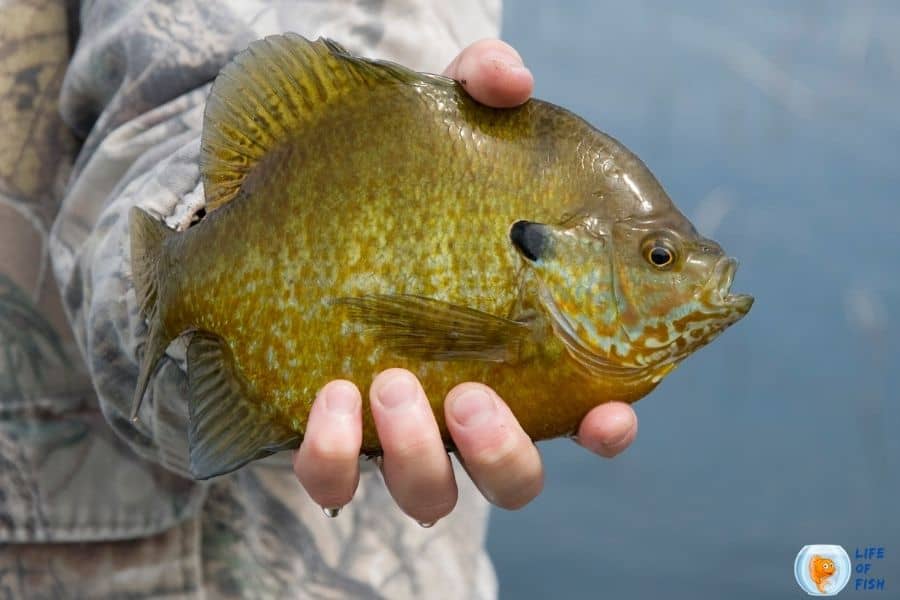
Male and female fish
All Centrarchidae species except the genus Micropterus develop an intense coloration between males and females.
Males generally have bright, vivid-colored bodies and females have pale-colored bodies.
Where do Lake Sunfish live?
Lake Sunfish habitats are in ponds, lakes, medium to low flow streams and rivers, and swamps situated in North America.
The waters are clear, warm, and slower-moving and generally have aquatic vegetation to protect them from predators.
Few species in the family can survive in extreme water conditions. For example, Sacramento perch can survive unusually high alkalinity, salinity, and temperatures in their habitats.
Preferred water columns vary to different species. For instance, Bluegill inhabits deeper littoral zones, while green Sunfish inhabit near the shoreline and shallower areas.
The preferred water temperature is 28 °C (82 °F) to 32 °C (90 °F) for most species. Some sunfish can survive in extreme weather conditions like water temperatures as low as 35 °F (1.7 °C) or as high as 106 °F (41 °C).
The temperature changes don’t affect sunfish reproduction ability much.
Lake Sunfish behavior
Lake Sunfish are nest builders. They dig saucer-shaped nests along the shoreline of ponds, lakes, and streams in late spring for reproduction.
The substrate in the nest is lighter than the surrounding area because the male fish scrape silt, algae, or other organic material within the nest area.
The nest is circular shaped and consists of mud, sand, or gravel.
Sunfish become aggressive and territorial when they build nests. They usually stay in schools, are primarily active at dawn, and feed in the morning and evening.
They remain hidden under cover during the day and move to shallow waters at night.
Sunfish are egg layers and good parents. Male fish build and guard nests, protect the eggs and fry until they are big enough to swim alone.
Before the females lay eggs in the nest, they perform a courtship dancing ritual. Usually, larger males attract more females.
What does Lake Sunfish eat
All lake sunfish are carnivores. Depending on the size and type of the fish, they eat small invertebrates (such as insects, crustaceans, and mollusks), snails, small fish, and crayfish.
The feeding style of some species is varied. Some fish species like Lepomis are suction feeders that generally feed off the bottom of their habitat.
And, some species like Micropterus are ram feeders that feed typically in more open areas known as the limnetic zone.
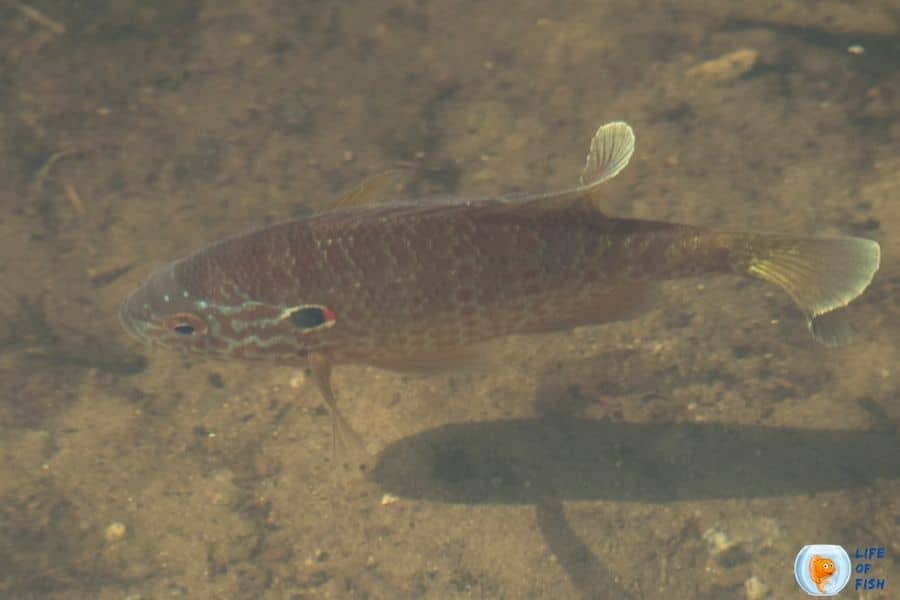
Lake Sunfish breeding
Lake Sunfish are adaptable and fast-growing fish species that can tolerate different weather conditions and still breed.
They show monogamous mating behavior. Males create nests to breed and care for the fry.
They become aggressive and territorial around their nests to protect them from unwanted visitors.
When the female Sunfish is ready to spawn, the couple engages in a courtship dance routine before the female Sunfish lays her eggs in the male’s nest.
Lake Sunfish are egg-layers; the female lays eggs while the male fertilizes them. Some weak males who are unsuccessful at courtship exhibit a cheater strategy by sneaking into the fertilization process by various methods.
Once they finish spawning, the female leaves the nest, and the male begins to protect the eggs.
The male Sunfish protects the eggs and fry until a few days after hatching. Then the guarding parent leaves the fry to survive on their own.
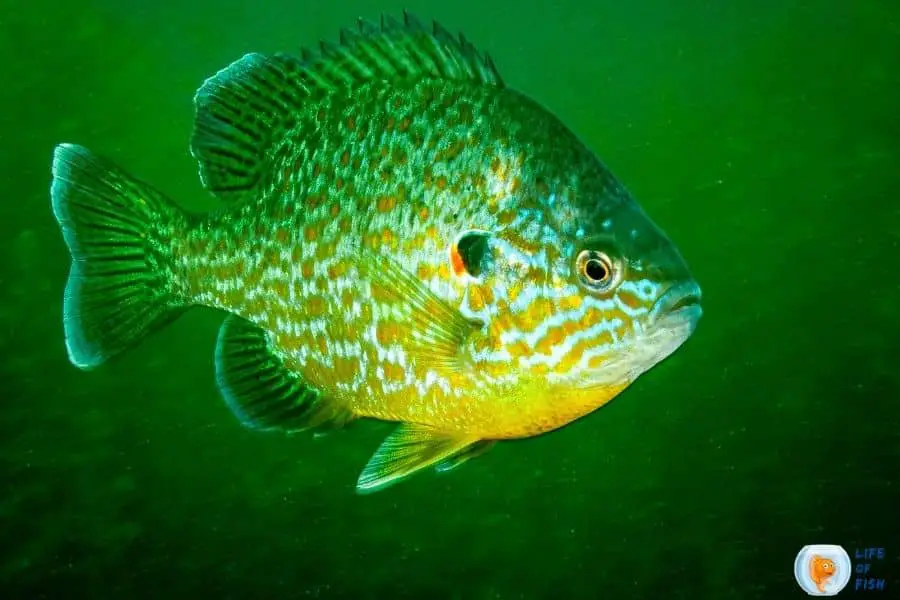
Importance of Lake Sunfish
Lake Sunfish (especially Largemouth Bass) are adaptable, fast-growing, and easy to harvest fish species.
Because of these reasons, this fish is widespread across China as a food fish. The meat is delicious with fewer bones which makes them attractive to consumers.
Moreover, many Lake Sunfish species can tolerate extreme weather conditions that can be advantageous in cold weather.
Ecosystem balance
Lake sunfish can be invasive outside of Native waters, wherein North America.
Some travelers introduced this fish to multiple continents, including Europe, South America, Africa, and Asia.
Therefore, you can find some of these species around the world. These fish pose a significant threat to native species in the areas they invade.
Moreover, the reports confirm that instances of largemouth bass are severely altering and reducing the native fish species in Italy, South Africa, Japan, and Madagascar.
Also, the local Cyprinodontidae species in Mexico are about to extinct because of this species.
Sport fishing
Lake Sunfish are popular among anglers because of their active and fighting behavior.
Moreover, this sport fishing is why people introduced these fish worldwide to stock them for recreational fishing.
As a food
Although this fish is not popular in commercial fishing in North America, Largemouth Bass is popular as a food fish in China.
The meat of this fish is delicious, and as the fish has few bones, consumers tend to like them. However, all species of the Centrarchidae family are edible.
Lake Sunfish vs. ocean Sunfish
Lake Sunfish are freshwater fish that live in ponds, lakes, medium to low flow streams and rivers, and swamps situated in North America.
And also, they are ray-finned fish that grow at a maximum of 3.3 feet long. On the other hand, ocean sunfish are marine water fish known as Mola Mola that typically weighs between 247 and 1,000 kg.
They are one of the two heaviest bony fishes in the world and live in tropical and temperate marine waters around the world.
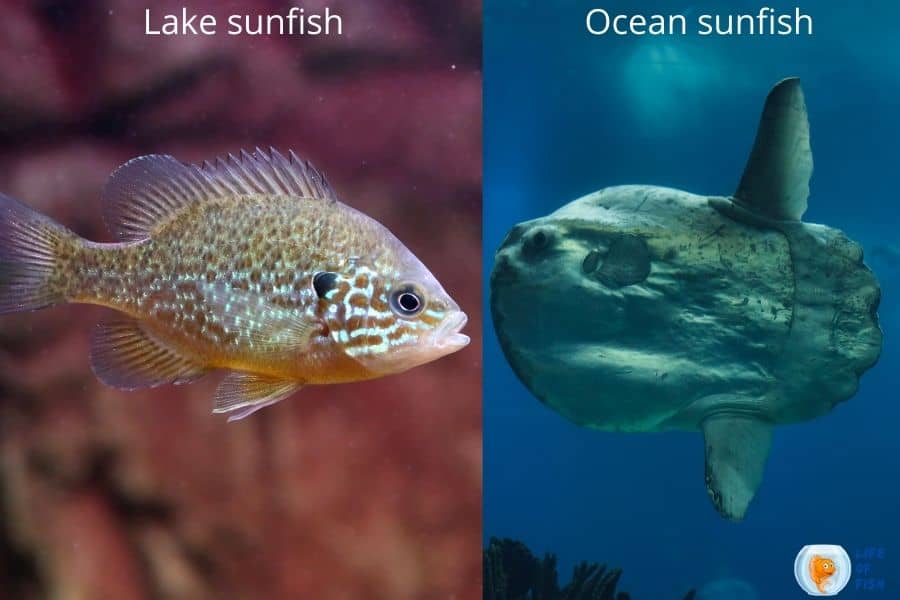
Related question
What kind of fish is a lake sunfish?
Lake Sunfish is a freshwater ray-finned fish that lives in ponds, lakes, medium to low flow streams and rivers, and swamps situated in North America.
Further, they are popular in New York and North America as game fish and popular in China as food fish.
Are Lake Sunfish rare?
No. Lake Sunfish are not rare. Actually, they are widespread around the world because of the introduction of recreational fishing.
Some fish species like Largemouth bass have even become a threat in some countries as they invade the area and predate the native fish species of those countries.
Are Lake Sunfish poisonous?
No. Lake Sunfish are not poisonous. Although they are not popular as food fish, the flesh of these fish is edible and delicious. They also contain few bones, which makes them easy to eat.
Can you eat Lake Sunfish?
Yes. You can eat all the Lake Sunfish species, and they are delicious.
Biggest lake sunfish ever caught
The biggest lake sunfish ever caught was a 22-pound, 5-ounce, 29-inch Largemouth Bass caught on Lake Biwa in Japan.
However, the world Guinness record holds the fish caught by George Perry in 1932 from Lake Montgomery in southern Georgia.
This Largemouth Bass weighed 22 pounds, 4 ounces. The IDFA requires that the new record outweighs the current record by more than two ounces.
Therefore, the IDFA listed the fish caught in Japan as a tied record.
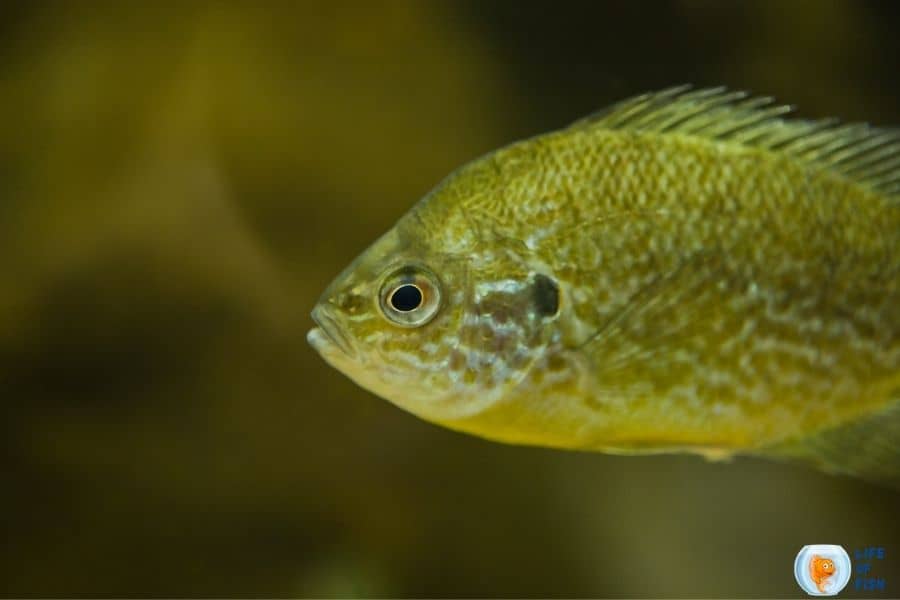
Conclusion
Lake Sunfish is a family of freshwater ray-finned fish that consists of 38 species. Among them, two species are extinct.
They inhabit freshwater sources in North America, and people introduced them to other continents for recreational fishing.
Lake Sunfish is popular among anglers as sporting fish, and people consider them as an invasive fish species outside its native waters.
Although these fish are not commercial fish, they are edible and delicious.
Read next: Mutton Snapper Fish | 10 Super Interesting Facts About The Fish

